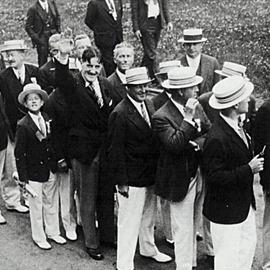
In 1934, the Harvard class of 1909 held its 25th reunion—then as now an occasion for members of the American elite to parade in public and celebrate their achievements. But this year the star attraction was a German: Ernst “Putzi” Hanfstaengl, the son of a Munich art dealer and publisher who had joined the Nazi movement and enjoyed personal access to Hitler (Hitler liked hearing him play the piano, as had his Harvard classmates, for whom he composed football fight songs). In the early 1930s he served as foreign press chief for the Nazi party.
When Hanfstaengl’s plan to attend the reunion became known, a scandal blew up. He declined to serve as an officer of his class, but he came, visited the estates of wealthy Harvard men around Boston, and took tea at the house of the current president, James Conant, who would later serve as American high commissioner, and still later ambassador, in postwar Germany.
Liberal journalists and politicians, especially in New York, denounced the Nazis and dwelled on Hanfstaengl’s support of their policies. A rabbi confronted him, two girls chained themselves to railings in Harvard Yard, and a few students from MIT protested and were arrested. But Harvard’s members, old and young, responded to such critics with striking solidarity. The Crimson denounced the demonstrators as “extremely childish.” Conant went ahead with plans to send the mathematics professor George Birkhoff, a staunch anti-Semite, as an official representative of the university to the 1936 anniversary celebration at the University of Heidelberg—an institution that, purged of its Jews, taught “German physics.”
Stephen Norwood, a distinguished American Jewish historian, tells these grim stories in a lucid, well-informed book: The Third Reich in the Ivory Tower. Many of the richest and oldest colleges and universities in the United States showed less understanding of Nazism than newspaper columnists like Heywood Broun (who, to be fair, also attended Harvard, where he met John Reed and Alan Seeger).
In some cases, university presidents did more than send greetings to the odd dictator. Nicholas Murray Butler of Columbia went back and forth to Europe on German ships, sent representatives to the big German university festivals—and expelled students and fired professors who protested. Worse still, he allowed Columbia’s Italian Academy to become a center of Fascist propaganda. Meanwhile the Seven Sisters welcomed Nazi exchange students and sent their own young women off to witness the wonders of German prosperity and order at the University of Munich.
At times, Norwood offers an indictment—a justified indictment—rather than a history. In his first chapter, he argues at length that any sentient American should have known what the Nazis stood for. He has a point. But it’s one thing to show that Conant and Butler came late to the war against Fascism, as they surely did (in 1940, Conant was appointed Chairman of the National Defense Research Committee, which oversaw the Manhattan project); quite another to explain why they were so blind and deaf.
The universities took their stand where they did for many reasons. Administrators believed in hierarchy, and they and many faculty disliked Jews. But many older professors and administrators—as Norwood nowhere indicates—had deeper reasons for viewing Germany through a haze of sympathy. American universities looked to the German ones as their models. Many scholars and scientists had actually begun their research careers in German libraries and labs. In Berlin, Butler saw that even Bismarck treated great professors with respect. Breaking those ties came hard.
Communism also played a big role in this ugly story. In the 1930s, the Party had cells and reading groups on all major campuses. They drew their members from the same anti-Fascists who opposed official visits by Nazis. The dignitaries who refused to help or listen to protestors often saw them as a threat in their own right to the republic. This fact can’t excuse their violations of student and faculty rights or their sympathy for the Nazi devil—but the historian can’t ignore it.
In some cases, Norwood fails to think his way outside the categories of modern American Judaism and into those of the 1930s. One of his minor characters is the long-term dean of Barnard College, Virginia Gildersleeve, who excused Nazi removal of Jews and women from German universities as a response to overcrowding. After the war, Norwood notes, Gildersleeve emerged as a passionate defender of the Palestinians and opponent of Zionism. The same anti-Semitism that inspired these activities presumably instilled her with warm feelings for the Nazis.
In fact, Gildersleeve was a complex character. A passionate believer in women’s rights and aspirations, she hired male professors to ensure Barnard’s high academic standing. Gildersleeve may well have wanted to cut the number of Jewish students in her college. But her opposition to the expulsion of Arabs from Palestine did not stem only from anti-Semitism. She shared her views with friends like Judah Magnes and called for the admission of 200,000 displaced Jews to the United States, even as she fought the founding of Israel. Yet somehow she also admired the early achievements of the Nazis (particularly for putting the male population back to work after the economic disasters of hyperinflation and slump), as she did the passion play at Oberammergau. No indictment can do justice to such complexities.
Advertisement
In the end, though, the complexities Norwood misses matter less than the central point he proves. It is a principle universally acknowledged that those in search of examples of civil courage waste their time if they look for them among university faculty members and administrators. That simple rule does much to explain why the denizens of great universities pretended not to see where the wind from the Rhine and the Tiber was blowing.
Stephen Norwood, The Third Reich in the Ivory Tower: Complicity and Conflict on American Campuses (Cambridge University Press, 2009)

